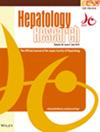高血清生长分化因子 15 是接受核苷(t)ide 类似物治疗的慢性乙型肝炎患者发生肝细胞癌的危险因素
IF 3.9
3区 医学
Q1 GASTROENTEROLOGY & HEPATOLOGY
引用次数: 0
摘要
目的慢性乙型肝炎(CHB)患者即使接受核苷(t)ide 类似物治疗,仍有罹患肝细胞癌(HCC)的风险。我们评估了发生 HCC 的风险因素,包括血清乙型肝炎病毒(HBV)RNA、乙型肝炎核心相关抗原水平和生长分化因子 15(GDF15)水平,后者是慢性丙型肝炎患者发生 HCC 的预测因子。方法我们收集了接受核苷(t)ide 类似物治疗 1 年以上、HBV DNA 水平低于 3.0 log IU/mL 且无 HCC 病史的慢性乙型肝炎患者的临床数据和储存的血清。我们检测了血清中 HBV RNA 和 GDF15 的水平。GDF15水平的中位数为0.86纳克/毫升。Cox 比例危险度分析显示,男性、较高的 GDF15、FIB-4 指数、甲胎蛋白和γ-谷氨酰转肽酶是导致 HCC 的独立危险因素。HBV RNA 高于定量下限不是风险因素。当我们根据尤登指数设定截断值时,男性组、甲胎蛋白≥3.0 ng/mL组、γ-谷氨酰转肽酶≥22 U/L组、FIB-4指数≥1.93组和GDF-15≥1.17 ng/mL组的HCC累积发病率明显更高。结论高血清GDF15是接受核苷(t)ide类似物治疗的CHB患者发生HCC的独立危险因素。本文章由计算机程序翻译,如有差异,请以英文原文为准。
High serum growth differentiation factor 15 is a risk factor for the occurrence of hepatocellular carcinoma in chronic hepatitis B patients treated with nucleos(t)ide analogs
AimPatients with chronic hepatitis B (CHB) remain at risk for hepatocellular carcinoma (HCC) even with nucleos(t)ide analog therapy. We evaluated risk factors for HCC development, including serum hepatitis B virus (HBV) RNA, hepatitis B core‐related antigen level, and growth differentiation factor 15 (GDF15) level, a predictor of HCC development in patients with chronic hepatitis C.MethodsWe collected clinical data and stored serum from CHB patients without a history of HCC who were receiving nucleos(t)ide analog treatment for more than 1 year and whose HBV DNA level was less than 3.0 log IU/mL. We measured the serum levels of HBV RNA and GDF15.ResultsAmong 242 CHB patients, 57 had detectable HBV RNA, and GDF15 was quantified in all patients. The median GDF15 level was 0.86 ng/mL. Cox proportional hazards analysis revealed that male sex and higher GDF15, FIB‐4 index, alpha‐fetoprotein and gamma‐glutamyl transpeptidase were independent risk factors for HCC. The presence of HBV RNA above the lower limit of quantification was not a risk factor. When we set cutoff values based on the Youden index, the cumulative incidence of HCC was significantly higher in the male, AFP ≥3.0 ng/mL, gamma‐glutamyl transpeptidase ≥22 U/L, FIB‐4 index ≥1.93, and GDF‐15 ≥1.17 ng/mL groups. In patients with no or more than three of these five risk factors, the 10‐year HCC cumulative incidence rates were 0% and 41.0%, respectively.ConclusionsHigh serum GDF15 is an independent risk factor for the occurrence of HCC in CHB patients treated with nucleos(t)ide analogs.
求助全文
通过发布文献求助,成功后即可免费获取论文全文。
去求助
来源期刊

Hepatology Research
医学-胃肠肝病学
CiteScore
8.30
自引率
14.30%
发文量
124
审稿时长
1 months
期刊介绍:
Hepatology Research (formerly International Hepatology Communications) is the official journal of the Japan Society of Hepatology, and publishes original articles, reviews and short comunications dealing with hepatology. Reviews or mini-reviews are especially welcomed from those areas within hepatology undergoing rapid changes. Short communications should contain concise definitive information.
 求助内容:
求助内容: 应助结果提醒方式:
应助结果提醒方式:


